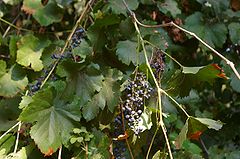Vitis
| Vitis Fossil range: 60 Ma Paleocene- Recent |
||||||||||||
|---|---|---|---|---|---|---|---|---|---|---|---|---|
 Vitis californica with fruit
|
||||||||||||
| Scientific classification | ||||||||||||
|
||||||||||||
| Species | ||||||||||||
|
Vitis is a genus of about 60 species of vining plants in the flowering plant family Vitaceae. The genus is made up of species predominantly from the Northern hemisphere. It is economically important as the source of grapes, both for direct consumption of the fruit and for fermentation to produce wine. The study and cultivation of grapevines is called viticulture.
Contents |
Biology

Vitis is distinguished from other genera of Vitaceae by having petals which remain joined at the tip and detach from the base to fall together as a calyptra or 'cap'. The flowers are unisexual or modified to act functionally as unisexual, they are pentamerous with a hypogynous disk. The calyx is greatly reduced or nonexistent in most species and the petals are joined at the summit into one unit but separated at the base. Flower buds are formed later in the growing season and overwinter for blooming in spring of the next year. There are two types of flowers produced, sterile flowers with five long filaments and erect stamens with undeveloped pistils and fertile flowers with well developed pistals and that have five undeveloped reflexed stamens. The fruit is a berry, normally produced with four or less per flower by way of aborted embryos, ovoid in shape and juicy.[1]
In the wild, all species of Vitis are normally dioecious, but under domestication, variants with perfect flowers appear to have been selected.
Most Vitis species have 38 chromosomes (n=19), but 40 (n=20) in subgenus Muscadinia. In that respect the Muscadinia are the same as other Vitaceae such as Ampelocissus, Parthenocissus, and Ampelopsis.
Uses
The fruit of several Vitis species are grown commercially for consumption as fresh grapes and for fermentation into wine. Vitis vinifera is the most important species.
The leaves of the grape vine itself are considered edible and are used in the production of dolmades.
Species

Most Vitis species are found in the temperate regions of the Northern Hemisphere in North America and Asia with a few in the tropics. The wine grape Vitis vinifera originated in southern Europe and southwestern Asia. The species occur in widely different geographical areas and show a great diversity of form. However they are sufficiently closely related to allow easy interbreeding and the resultant interspecific hybrids are invariably fertile and vigorous. Thus the concept of a species is less well defined and more likely represents the identification of different ecotypes of Vitis that have evolved in distinct geographical and environmental circumstances.
The exact number of species is not certain, with species in Asia in particular being poorly defined. Estimates range from 40 to more than 60.[2] Some of the more notable include :
- Vitis vinifera, the European grapevine. Native to the Mediterranean and Central Asia.
- Vitis labrusca, the Fox grapevine, sometimes used for wine. Native to the Eastern United States and Canada.
- Vitis riparia, the Riverbank Grapevine, sometimes used for winemaking and for jam. Native to the entire Eastern U.S. and north to Quebec.
- Vitis aestivalis, the Summer Grape, native to the Eastern United States, especially the Southeastern United States.
- Vitis rotundifolia (syn. Muscadinia rotundifolia), the Muscadine, used for jams and wine. Native to the Southeastern United States from Delaware to the Gulf of Mexico.
- Vitis coignetiae Crimson Glory Vine, a species from East Asia grown as an ornamental plant for its crimson autumn foliage.
- Vitis amurensis, native to the Asian continent, including parts of Siberia and China.
There are many cultivars of grapevines; most are cultivars of V. vinifera.
Hybrid grapes also exist, and these are primarily crosses between V. vinifera and one or more of V. labrusca, V. riparia or V. aestivalis. Hybrids tend to be less susceptible to frost and disease (notably phylloxera), but wine from some hybrids may have a little of the characteristic "foxy" taste of V. labrusca.
Commercial distribution

According to the "Food and Agriculture Organization" (FAO), 75,866 square kilometres of the world is dedicated to grapes. Approximately 71% of world grape production is used for wine, 27% as fresh fruit, and 2% as dried fruit. A portion of grape production goes to producing grape juice to be used as a sweetener for fruits canned "with no added sugar" and "100% natural". The area dedicated to vineyards is increasing by about 2% per year.
The following list of top wine-producers shows the corresponding areas dedicated to grapes for wine making:
- Spain 11,750 km²
- France 8,640 km²
- Italy 8,270 km²
- Turkey 8,120 km²
- United States 4,150 km²
- Iran 2,860 km²
- Romania 2,480 km²
- Portugal 2,160 km²
- Argentina 2,080 km²
- Australia 1,642 km²
- Lebanon 1,221 km²
Sources: FAO, Organisation Internationale de la Vigne et du Vin (pdf), Australian Wine and Brandy Corporation.
Pests and diseases

Phylloxera is an American root aphid that devastated V. vinifera vineyards in Europe when accidentally introduced in the late 19th century. Attempts were made to breed in resistance from American species, but many winemakers didn't like the unusual flavour profile of the hybrid vines. Fortunately, V. vinifera grafts readily onto rootstocks of the American species, and most commercial production of grapes now relies on such grafts.
The Black vine weevil is another root pest.
Grapevines are used as food plants by the larvae of some Lepidoptera species - see list of Lepidoptera that feed on grapevines.
See also
- Annual growth cycle of grapevines
- Canopy (vine)